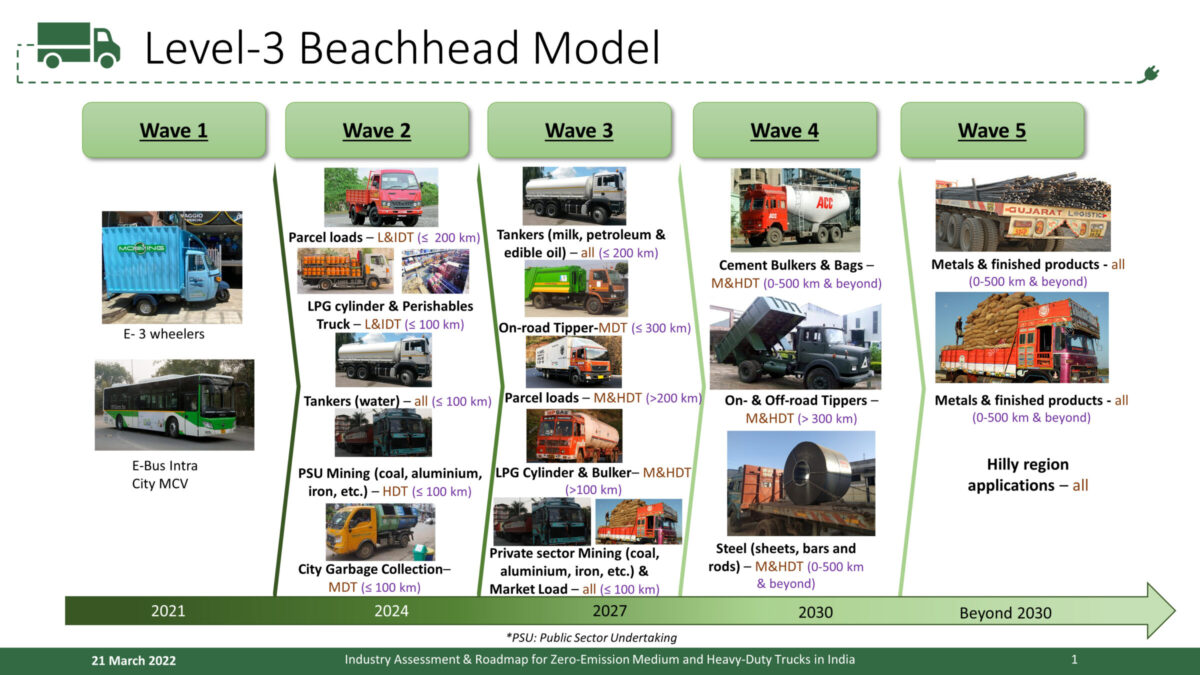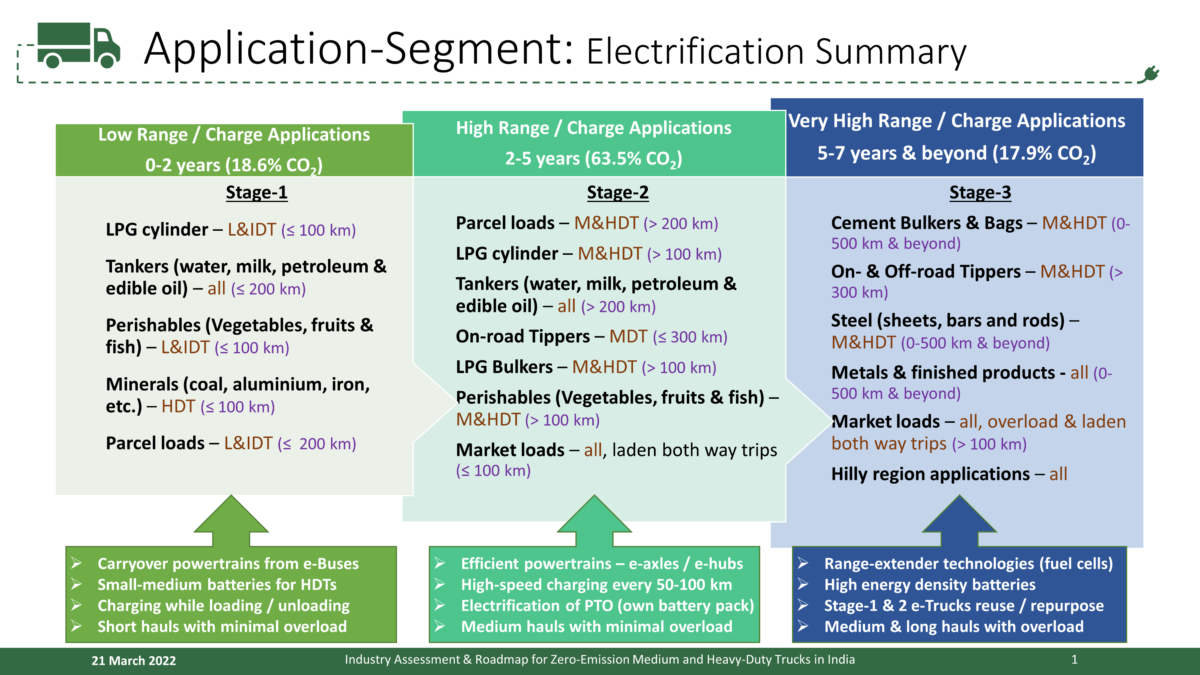As the 6th largest truck market in the world, India is a key region for CALSTART’s Drive to ZeroTM program and campaign, and can play an important role in achieving the transition to zero-emission medium- and heavy-duty vehicles (ZE-MHDVs). And given significant fuel imports and transportation-sector pollution impacts, decarbonizing India’s heavy-duty vehicle fleet represents a strategic opportunity to improve air quality and address health impacts in tandem with other national priorities around energy security and industrial competitiveness.
While India is a global leader in electric two- and three-wheeler deployment, and has begun making headway in zero-emission bus (ZEB) deployment through the FAME II incentive scheme and other supporting policies, medium- and heavy-duty trucks have mostly been excluded from India’s electro-mobility transition. To better support the transition to ZE-MHDVS in India, CALSTART recently commissioned an industry assessment and roadmap for zero-emission medium- and heavy-duty trucks (ZE-MHDTs) in India, conducted by the clean technology consultancy pManifold.
This wide-ranging study included a review of the existing truck manufacturing landscape, truck fleet landscape, a techno-commercial feasibility assessment of ZE-MHDTs based on real-world duty cycles, an assessment of industry readiness for ZE-MHDT manufacturing, and a roadmap for ZE-MHDT deployment.
We are pleased to share this summary of the some of the key findings, and look forward to working with government and industry partners to use these findings to accelerate the deployment of zero-emission trucks (ZETs) in India as part of the overall transition to ZE-MHDVs.
Towards an Indian Beachhead Strategy
From experience working closely with the State of California, Drive to Zero recognizes the need for an ecosystem approach to transition to ZE-MHDVs, including an aligned and mutually-reinforcing mix of clear and ambitious goals, strong regulations, and targeted incentives. A key component of California’s ecosystem approach is the beachhead strategy, which recognizes that ZE-MHDV technology will come in waves, starting with vehicle segments like transit buses that travel known, fixed routes and return to base for charging. In adopting this beachhead strategy, California has focused early incentives and regulations on ZEBs, recognizing that vehicle technology can be transferred from ZEBs to other vehicle segments as technology improves, production volumes increase, and costs comes down.
Building on ZEB deployment progress, it will be important for India to adopt a similar beachhead strategy, recognizing that not all truck segments can be electrified immediately. Instead, it is important to identify the truck applications that are most feasible now, focus immediate policy and investment efforts there, and develop a strategy for scaling technology over time to more challenging applications and segments.

Through real-world duty-cycle modelling, pManifold identified several truck segments have sufficient power and range using existing battery electric vehicle technology, which could serve as first wave beachhead segments. Representative duty cycles were created using real-life GPS and telematics data compiled from internal combustion engine-powered trucks operating across India, involving diverse truck applications running in various geographies and terrains. Successful e-truck segments include:
- 11T produce trucks
- 11T LPG Cylinder trucks
- 29T milk tankers
- 40T water tankers
- 29T coal and mineral haulers
- 55T coal and mineral haulers
Based on the analysis, this first wave of potential e-truck segments, responsible for an estimated 18.2% of total CO2 emissions across India’s truck fleet, can be electrified using existing battery and powertrain technology from e-buses and supported by depot- and/or origin-and-destination-based charging.

Recognizing Challenges
In addition to promising opportunities, the industry assessment also identified challenges within India’s trucking sector that will require additional attention in the transition to zero-emission technology. For example, based on industry stakeholder interviews and surveys, an estimated 25-30% of the medium- and heavy-duty truck fleet in India is prone to 50-70% cargo overloading above GVWR. This propensity for overloading can reduce battery performance and vehicle range, and negatively impact ZET total cost of ownership performance.
India’s truck fleet is also very fragmented – an estimated 55% of truck buyers are individuals, and 70% of truck fleets are small fleet operators with less than 6 trucks. These fleets will likely face financing and economic barriers to electric truck adoption, and without incentives, awareness, and other demand-side policies, OEMs are unlikely to receive demand signals sufficient to promote e-truck R&D and investment.
In addition, conventional internal combustion engine-powered truck manufacturing and sales often include an unorganized finishing and fit-out process. Trucks are sold partially built, and truck buyers often customize the cabin and load body fit-out, mostly via an informal, cash-based market.
These aspects of the truck market will need to be taken into consideration when scaling zero-emission truck manufacturing in India, possibly leveraging some of industry standards for bus body design that have supported e-bus manufacturing.
State-Level Action
In addition to central government policies supporting India’s e-mobility transition, there are significant State level efforts to develop EV policies, though these typically only focus on light-duty vehicles and buses. In fostering a supportive ecosystem, it will be critical for state governments in India to take a proactive role in establishing both regulations and incentives for ZE-MHDVs, including ZETs.
Having endorsed the Global MOU announced at COP26 last year, the State of Telangana has signaled strong support for ZE-MHDVs and the Global MOU ambition of transitioning to 100% sales of new ZE-MHDVs by 2040. With the growth of the e-commerce industry in Hyderabad, including large fulfillment centers for companies like Amazon and Flipkart, Telangana can be leader in supporting early ZET deployments and developing some of the policy solutions required to accelerate India’s transition to ZE-MHDVs.
In its 2021 Electric Vehicle Policy, the State of Maharashtra established a target to make four highways fully EV ready by 2025, and identified the need for corridor charging specifically for long-haul electric trucks. This is a noteworthy development as one of the only references to heavy-duty vehicle electrification in a state-level EV policy document, and important starting point in supporting ZET deployments in Maharashtra.
Building on some of these early ambitions and targets, Drive to Zero looks forward to collaborating with government, industry, and NGO partners in India to share the results of the industry assessment and accelerate the deployment of ZE-MHDVs.
